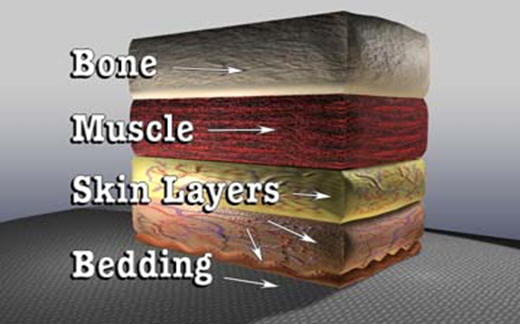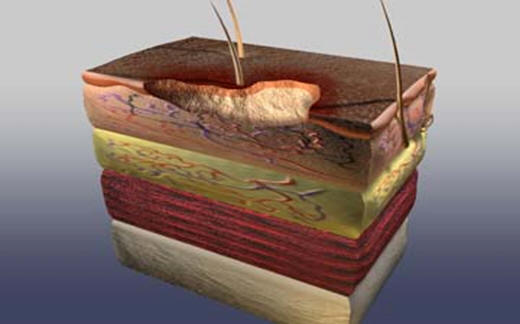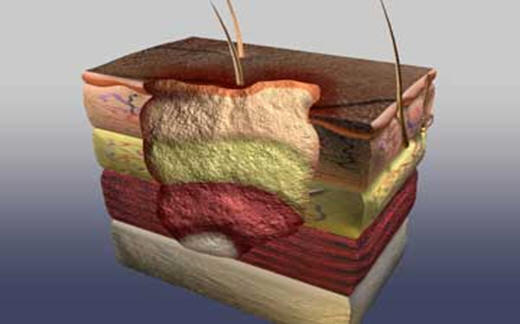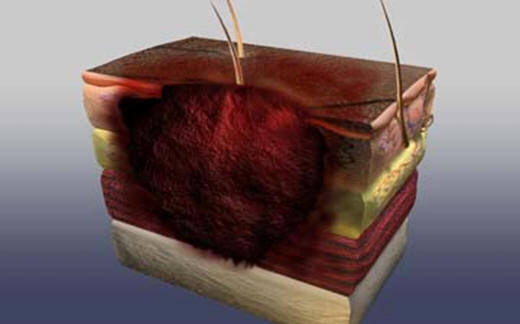|
 Instructions
Instructions
 Take Another Course
Take Another Course
 Post-Test
Post-Test
|
Pressure Injuries
|
3
Condition contribute to skin breakdown:
•Friction
•Shear
•Moisture
|
|
|
Classification schemes vary depending on the type of wound. First we
will discuss--
Pressure Injuries
Three conditions contribute to skin breakdown in pressure injuries,
including friction, shear, and moisture. Friction is abrasion that removes the outermost layer
of skin (stratum) and damages underlying skin layers, which are more
delicate and subject to damage than the skin. Shear combines gravity
and friction, causing the separation of tissue parallel to skin
surface. The impact of shear depends on pressure, “slipperyness”
between materials, and how much skin is in contact with surfaces.
This type of wound appears shaved without cratering and is usually
present over a large surface area. Moisture may be present from
incontinence or perspiration and may cause maceration and
overhydration of the epidermis. This makes the skin less tolerant to
pressure forces. |


|
Stage |
Definitions |
|
|
I |
Non-blanchable erythema of intact skin. |
 |
|
II |
Partial thickness skin loss involving
epidermis and/or dermis. |
 |
|
III |
Full thickness skin loss involving damage
or necrosis of subcutaneous tissue that may extend down
to, but not through, underlying fascia. This presents
clinically as a deep crater. |
 |
According to the WOCN guidelines, a pressure injury is any
lesion caused by unrelieved pressure resulting in damage to the
underlying tissue. Pressure injuries usually occur over boney
prominences and are staged to classify the degree of tissue
damage.
During the National Pressure Ulcer Advisory Panel’s 2016 Staging Consensus Conference in April 2016 an
updated set of staging definitions was validated. We will
describe the updated terminology and definitions here.(1)
Stage 1: Non Blanchable erythema of intact skin.
Intact skin with a localized area of non-blanchable erythema,
which may appear differently in darkly pigmented skin. Presence
of blanchable erythema or changes in sensation, temperature, or
firmness may precede visual changes. Color changes do not
include purple or maroon discoloration; these may indicate deep
tissue pressure injury.
Stage 2: Pressure Injury: Partial-thickness skin loss with
exposed dermis.
The wound bed is viable, pink or red, moist, and may also
present as an intact or ruptured serum-filled blister. Adipose
(fat) is not visible and deeper tissues are not visible.
Granulation tissue, slough and eschar are not present. These
injuries commonly result from adverse microclimate and shear in
the skin over the pelvis and shear in the heel. This stage
should not be used to describe moisture associated skin damage (MASD)
including incontinence associated dermatitis (IAD),
intertriginous dermatitis (ITD), medical adhesive related skin
injury (MARSI), or traumatic wounds (skin tears, burns,
abrasions).
Stage 3: Pressure Injury: Full-thickness
skin and tissue loss.
Full-thickness loss of skin, in which adipose (fat) is visible
in the ulcer and granulation tissue and epibole (rolled wound
edges) are often present. Slough and/or eschar may be visible.
The depth of tissue damage varies by anatomical location; areas
of significant adiposity can develop deep wounds. Undermining
and tunneling may occur. Fascia, muscle, tendon, ligament,
cartilage and/or bone are not exposed. If slough or eschar
obscures the extent of tissue loss this is an Unstageable
Pressure Injury. |
|
Stage |
Definitions |

 |
|
IV |
Full thickness loss with extensive destruction, tissue
necrosis or damage to muscle, bone or supporting
structures. |
|
Unstageable |
Covered with eschar or slough. |
|
Suspected deep tissue injury |
Purple or maroon in color. Localized area of discolored
intact skin or blood-filled blister due to damage or
underlying tissue. |
Stage 4: Pressure Injury: Full-thickness skin and tissue loss.
Full-thickness skin and tissue loss with exposed or directly
palpable fascia, muscle, tendon, ligament, cartilage or bone in
the ulcer. Slough and/or eschar may be visible. Epibole (rolled
edges), undermining and/or tunneling often occur. Depth varies
by anatomical location. If slough or eschar obscures the extent
of tissue loss this is an Unstageable Pressure Injury.
Unstageable: Obscured full-thickness skin and tissue loss.
Full-thickness skin and tissue loss in which the extent of
tissue damage within the ulcer cannot be confirmed because it is
obscured by slough or eschar. If slough or eschar is removed, a
Stage 3 or Stage 4 pressure injury will be revealed. Stable
eschar (i.e. dry, adherent, intact without erythema or
fluctuance) on the heel or ischemic limb should not be softened
or removed.
(Suspected) Deep Tissue Injury: Persistent non-blanchable deep
red, maroon or purple discoloration.
Intact or non-intact skin with localized area of persistent non-blanchable
deep red, maroon, purple discoloration or epidermal separation
revealing a dark wound bed or blood filled blister. Pain and
temperature change often precede skin color changes.
Discoloration may appear differently in darkly pigmented skin.
This injury results from intense and/or prolonged pressure and
shear forces at the bone-muscle interface. The wound may evolve
rapidly to reveal the actual extent of tissue injury, or may
resolve without tissue loss. If necrotic tissue, subcutaneous
tissue, granulation tissue, fascia, muscle or other underlying
structures are visible, this indicates a full thickness pressure
injury (Unstageable, Stage 3 or Stage 4). Do not use DTPI to
describe vascular, traumatic, neuropathic, or dermatologic
conditions.
|
|
|